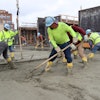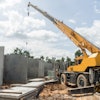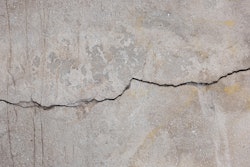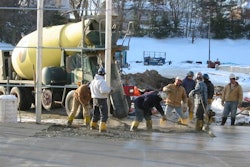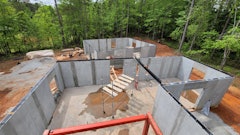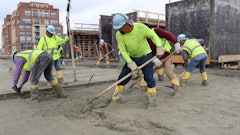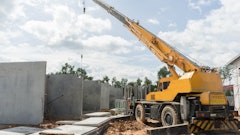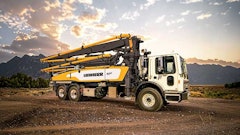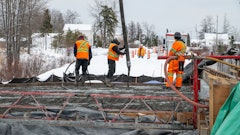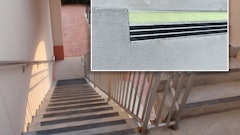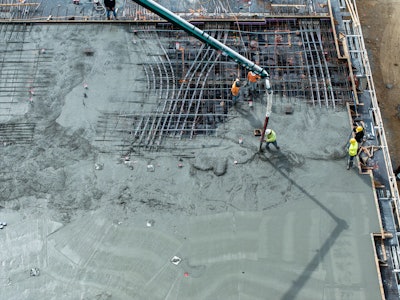
Concrete properties and quality testing are advancing as new technologies enter the industry. Traditional methods, such as break tests, remain widely accepted in standardized practices, but jobsites today demand precise and timely data. The most innovative projects now use digital tools that allow crews to monitor concrete workability and concrete strength continuously and in real time from batch to pour.
What are the key innovations transforming how concrete properties are measured and managed? Let’s take a glimpse into modern methods that support better decision-making, improve quality assurance, and enhance scheduling.
Why Traditional Concrete Testing Isn’t Enough
For decades, concrete quality control has relied on a few established methods, such as compressive cylinder breaks, slump cone tests, and air content checks, to measure performance. While still valuable, these practices provide only isolated data points. Cylinder breaks occur days or weeks after casting, long after mix designs leave the plant; slump tests at the chute tell you little about the consistency during transport; and field‑cured cylinders can be compromised by handling errors.
A mix may be perfect leaving the plant, yet variations in moisture, temperature, or revolutions in transit can alter slump by the time it reaches the site.
This disconnect can lead to rework and added costs. A mix may be perfect leaving the plant, yet variations in moisture, temperature, or revolutions in transit can alter slump by the time it reaches the site. On the job, crews may strip formwork or apply load based on fixed curing assumptions instead of actual strength.
As projects grow more complex and timelines tighten, these blind spots create risk. Modern, data-driven approaches bridge these gaps by capturing a complete picture of concrete behavior at different stages, starting with mix optimization and quality checks at the batch plant, continuing with real‑time slump and temperature monitoring during delivery, and culminating with on‑site strength measurement. Combined with targeted lab testing and visual inspections, these tools strengthen quality control at every stage.
Let’s look at five modern methods helping contractors and producers improve decision-making, enhance quality assurance, and keep schedules on track.
1. Maturity Monitoring with Wireless Embedded Sensors
One of the most commonly adopted modern techniques is maturity monitoring. Based on ASTM C1074, this method links temperature history with strength gain by using embedded sensors placed directly in the concrete pour. Modern maturity sensors:
Track temperature and calculate strength automatically in real time
Reduce the need for field-cured break tests in many cases
Provide wireless data access through mobile apps or cloud dashboards
Integrate with scheduling or BIM platforms for smoother communication, if necessary
Unlike wired technologies that require manual thermocouple readings and spreadsheets, newer systems offer long battery life, and cloud synchronization. This allows field teams and project managers to check in-place strength without waiting for lab results or physical data retrieval. These advances also help with quicker and safer decision-making.
For example, premature structural loading. This happens when weight or stress is put on concrete before it is strong enough to handle it. Taking off formwork or applying post-tensioning too soon can lead to cracks, changes in shape, partial failures, or in worst-case scenarios, blowouts. This compromises the structure’s safety and integrity. Modern real-time strength monitoring helps reduce this risk by giving accurate information on when concrete reaches the required strength, improving safety and productivity.
 @Aisyaqilumar - stock.adobe.com
@Aisyaqilumar - stock.adobe.com
2. Real-Time Slump & Workability Monitoring
Slump is one of the most widely used indicators of concrete workability. It measures how much a concrete sample settles or 'slumps' after being put and consolidated in a standard cone and then released (ASTM C143). While straightforward, its accuracy can vary based on environmental conditions and operator technique. For projects that need strict control over mix performance, especially during pumping or placing, real-time workability monitoring offers significant benefits. Emerging systems now enable:
In-transit slump tracking with non-invasive sensors installed in ready-mix trucks
On-site automated measurement
Continuous data collection linked to batch records and delivery times
These technologies give a clearer view of how concrete behaves from batching to placement. They help ensure consistency, reduce rejected loads, and promote more efficient scheduling. For concrete truck drivers, the ability to detect and fix slump issues in real time decreases variability and keeps pours on schedule. It also assists batch plant teams when adjusting loads in the yard, offering an added layer of safety and quality control through continuous monitoring.
3. Self-Calibrating Strength Sensors
A major leap in concrete monitoring technology comes from self-calibrating strength sensors. Traditional maturity methods require creating a calibration curve for each mix. Self‑calibrating sensors go a step further to remove manual calibration and mix dependency.
Some self-calibrating strength sensors use Concrete Electro-Mechanical Microstructural Analysis (CEMMA) technology to directly measure the concrete microstructural response. The result is real-time strength data with high accuracy, regardless of the weather, changes to your mix order, or variability of mixes from truck to truck.
By automatically adjusting to different mix designs and environmental conditions, self-calibrating sensors provide a new form of precision. Using this innovation means plant managers can trust the strength data for multiple mix designs, and site crews can pour, strip, and post-tension with greater confidence, without worrying about mix fluctuations affecting concrete quality.
4. Acoustic Resonance and Ultrasonic Pulse Echo Testing
Acoustic methods are gaining renewed interest thanks to improvements in sensor design and signal processing. Devices that use resonance frequency shifts or ultrasonic echo patterns can evaluate early-age strength development and internal flaws without damaging the concrete. These systems:
Detect changes in stiffness and modulus over time
Identify voids, honeycombing, or other defects in precast elements and cast‑in‑place structures.
Provide non‑destructive thickness and internal imaging, useful in precast plants or for quality assurance on critical elements like bridge girders.
While these acoustic techniques are not yet as widely used as maturity sensors, they provide valuable supplemental insights, particularly in controlled settings or high-performance concrete applications.
5. Cloud-Connected Dashboards and Data Integration
Perhaps the most significant shift for contractors is not only in the sensors but also in how data is managed and delivered. Most modern monitoring platforms now offer:
Unified dashboards combining batch plant mix design metrics, in-transit mix data, and on‑site strength measurements.
Mobile dashboards for on-site decision-making and automated alerts when thresholds are crossed.
Cloud syncing with project management platforms
Automated alerts for strength thresholds or anomalies
Historical reporting for Quality Assurance (QA) documentation
AI‑powered analytics that optimize mix designs, predict future strength development, and identify anomalies or inefficiencies across the supply chain.
This connectivity eliminates manual steps from the concrete testing process, providing real-time insights to batch plant QA/QC technicians, concrete mix drivers, and field teams get quick access to strength and workability data to confidently plan critical jobsite operations.
Artificial intelligence is increasingly important in this evolution. Platforms that use machine learning can examine large amounts of performance data to improve mix designs, forecast future strength, and support more precise scheduling decisions. These tools are shifting modern QA/QC from reactive to predictive, enabling crews to make proactive adjustments before issues arise. Many of these platforms have user-friendly dashboards and mobile interfaces. This design makes it easier to use with little training, even on the busiest days.
In an industry where every hour matters, real-time insights are becoming the new standard.
A New Standard for Strength Monitoring
Modern methods do not aim to replace all traditional tests. Rather, they supplement them with continuous, transparent data across the delivery chain. By decreasing uncertainty and minimizing risk, these innovations give contractors and ready-mix producers better control over schedules and budgets. From optimizing mixes at the batch plant, to monitoring slump and temperature in transit, to measuring in‑place strength on site, they unlock faster, safer decisions and reduce costs associated with low breaks, rejected loads, and unnecessary waiting. Most importantly, they fit in seamlessly with how concrete operations function today, allowing for fast integration and minimized training.
Embracing real-time strength and workability monitoring is changing the management of concrete performance. Whether through maturity sensors, self-calibrating sensors, automated slump tracking, or data-integrated dashboards, these methods empower crews to respond to conditions as they arise, not after the fact. In an industry where every hour matters, real-time insights are becoming the new standard.


